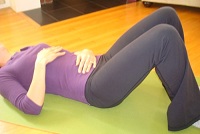When you’re feeling stressed or overwhelmed, one of the most effective ways to calm your body, mind and emotions is to pay attention to your breathing. When you focus your attention on your breath, things start to slow down. Physiologically, your heart rate slows, your blood pressure drops, and any tightness or tension you feel tends to relax. Breathing mindfully also calms your emotions, making them more manageable, and helps slow down a racing mind.
In the next post, we’re going to learn a few techniques to help you follow your breath, but first, it’s important to ensure that you’re breathing in a way that helps calm you, rather than in a way that can increase your level of stress.
There are two mains ways people breathe. The first is called abdominal breathing. It’s the natural way to breath, and the way we breathe when we’re born. In abdominal breathing, the abdomen expands when you inhale, and contracts when you exhale.
However, when we are feeling stressed or anxious, we often start breathing from the chest. This type of breathing is more rapid and shallow (taken to extremes it becomes panting), and tends to increase tension, especially in the chest, a feeling that’s often associated with stress, anxiety and sadness. When you breathe from the chest, the chest rises when you inhale, and falls when you exhale.
 Take a moment to check how you’re breathing right now. Place one hand on your chest and one hand over your belly button. Now, without trying to change anything, just notice how your hands move as you breathe in and out. This exercise can be easier to do if you’re lying down or standing, but sitting can work fine, too.
Take a moment to check how you’re breathing right now. Place one hand on your chest and one hand over your belly button. Now, without trying to change anything, just notice how your hands move as you breathe in and out. This exercise can be easier to do if you’re lying down or standing, but sitting can work fine, too.
If you’re breathing from the abdomen, the hand on your stomach will move as you breathe. Depending on your position (sitting, standing or lying down) the hand on your stomach will move up and/or out as the abdomen expands on each breath in, and then down and/or in as the abdomen contracts on each breath out. The hand on your chest won’t move much if at all.
If you’re breathing from the chest, you’ll notice that the hand on your chest moving up and/or out on each breath in, and then down and/or in on each breath out. The hand on your stomach won’t move as much, or you may find that it moves opposite to the hand on your chest, i.e. down or in on each in-breath, and up or out on each out breath.
If you find you’re already breathing from your abdomen, then jump over to the next post on Following Your Breath Mindfully. If you’re breathing from the chest, then first you need to retrain your breathing a bit and learn to breathe from your abdomen.
Here is an exercise to help you relearn abdominal breathing. You can do the exercise lying down or sitting.

- Place your hands just below your belly button.
- Close your eyes and imagine a balloon inside your abdomen
- Each time you breathe in, imagine the balloon filling with air. Feel your abdomen expand as the balloon fills.
- Each time you breathe out, imagine the balloon collapsing. Feel your abdomen contract as the balloon empties.
Sometimes when people focus on their breathing they breathe deeper, and/or more rapidly. This can make you feel anxious, dizzy, or light-headed. If this happens to you, just pause the practice until you start breathing normally again and the symptoms disappear. Then begin again.
If you’re used to breathing from your chest, it may take a while before abdominal breathing becomes habitual. If you practice the exercise above a few times throughout the day, eventually you’ll train yourself breathe abdominally without having to think about it. You may also find that if you are feeling stressed or overwhelmed, spending a couple of minutes doing the exercise above will help you calm and relax yourself.
Once you become comfortable with abdominal breathing, you’re ready to move on to the breathing exercises in the next post, Following Your Breath Mindfully.




